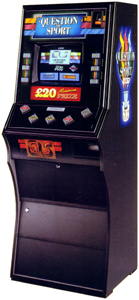Content
Konix Multi-system Archive
Here you will find the details of every known physical remnant of the
Konix Multi-system project, including what preceded it, and what came after
it. If any items are discovered, they will be catalogued here and
recorded.
This pertains only to items that I have in my possession or that I can
confirm really exist (and haven't yet been able to procure or see for myself
with my own eyes).
If someone else has a private collection of items relating to the Konix
Multi-system, if they can prove their items really exist with convincing
photos then I will gladly post them here (anonymity guaranteed).
Konix Slipstream Prototype Chip
Donated by: Chris Green
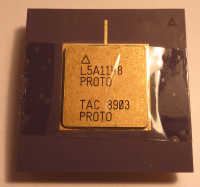
Prototype Slipstream ASIC

Slipstream ASIC chip pins
seen from underneath
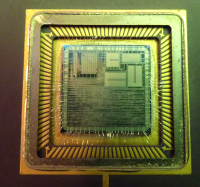
Under the cover:
Peeking inside the ASIC
This was just one of the many things donated by Chris Green.
This Slipstream chip allows us to glimpse inside the heart of the Konix Multi-system.
I don't have any way of knowing if it functions, it almost doesn't matter. As the prototype, it should remain as it is. I also don't know how different this chip was internally from the "final" version of the chip they would have used for mass-production.
I do know that it was packaged differently to what would have been the final production chip (it would have been a surface mount chip as in the photo below of the PCB).
With many thanks to John McMaster who has imaged the prototype and production chips with a very high resoloution microscope, you can now very closely inspect the chips using the zoom functions at these links:
https://siliconpr0n.org/map/konix/l5a1148/mcmaster_mz_mit20x2/
https://siliconpr0n.org/map/konix/l5a1364/mcmaster_mz_mit20x2/
Production PCB
Donated by: Chris Green

Multi-system Production PCB
This is the Printed Circuit Board (PCB) that would have been used in the final Konix Multi-system that you and I would have bought. It fits very snuggly into the plastics (seen below). Although I don't really want to snap off the surrounding frame - I may just do that one day so that it can be demonstrated how this would have fit.
If I ever find the Circuit Diagram that matches this PCB, then I will consider populating it with the appropriate components (after all, the ASIC is the only non-standard part so I should be able to source everything needed if a circuit diagram turns up one day. Without a circuit diagram it's pure guess work with a million permutations of component type and values that I could choose. Get just one wrong and the whole thing might not work - A million to one chance that it may work... those aren't great odds!
This chip in the photo was taped to the board when I received it and hasn't been soldered on. I don't know if that particular chip is functioning and therefore would work if the rest of the board was populated with the correct components.
The Konix Multi-system Plastic Case
Donated by: Chris Green
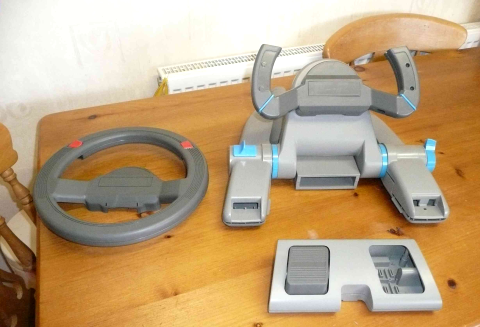
Real Multi-system Plastic case
This is it... this isn't the mass produced case that was used as a PC controller that's been painted another colour. This is the real plastic that was produced for the Multi-system. This is as close as anyone has come to a Multi-system for 20 or so years.
Thanks to Chris's liberation of these parts they have been preserved
(there would have been thousands of them produced at the factory so no-one
would have noticed or minded if just one set got liberated).
Chris mistakenly took two left pedals - however that really doesn't
matter.
In this picture there is a cavity where the 3.5 inch Floppy Disk Drive is
housed. I can report (and will take more pictures later) that the floppy
drive I have added to it at home fits perfectly with no effort at all.
There are some pegs that are molded into the case that keep this perfectly
located in place. I haven't had to modify anything to get it to fit.
Konix Multi-system Dev-Kit
Loaned by: Brian Pollock

Konix Multi-system Dev-Kit
The dev-kit consists of an early, but functional version of the Konix Multi-system Printed Circuit Board with the Intel 8080 chip, 128K of RAM and a PDS interface card in the expansion port (the interface which would otherwise have been used for plugging in cartridge games).
N.B. this PCB isn't the same shape or form that would go on to be used in the final console. Once the system was proven to work electronically, it would have been productionised (made fit for mass production) and it's layout would have been changed to fit the profile of the intended housing, some component choices would have been altered based on Engineers and Developers observations. Modifications and bug fixes would also get incorporated in the latter revision of the PCB that would find it's way into the home console.
The 128K memory is housed on a separate PCB, where there is also an EPROM which contains the PDS code to receive game data to be run on the system through the interface card from a PC.
This unit was initially all I was loaned. It is not enough on it's own (in fact it's basically half a system) and needs a suitable PDS PC interface card and the correct version of the PDS software running on a suitable PC.
This part is where I'm struggling to scrape together what I need. I also don't have circuit diagrams of the system or pinouts of connectors and the such - so getting it running is a challenge - but I will persevere.
The Bell-fruit Arcade System Circuit Board
Purchased on eBay
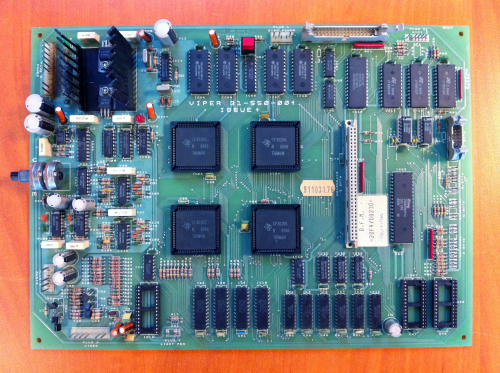
Bell-fruit PCB with Flare AVP Chipset
This is a circuit board from the Bell-fruit game Inquizitor (the first game where Bell-fruit used the Flare AVP chipset).
Also, I believe this is the game that had a custom attract sequence written by ATD.
Konix Navigator "Limited Edition" Joystick
Purchased on eBay

Limited "Multi-system edition"
and Standard Navigator Joysticks
Someone's told me that there were only 500 of these produced, they used the same colour scheme as the Multi-system plastics seen above - these joysticks were to be bundled with the Multi-system.
They were later sold as a "Limited Edition" - it would have been very easy to recoup the costs of producing them - after all it was a standard Konix joystick anyway, and it takes nothing to squirt some different coloured plastic into a injection mold.
Flare One Prototype PCB
Loaned by: Martin Brennan
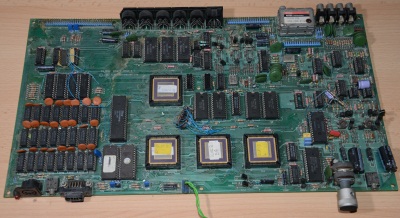
The real Flare One Prototype - a bit rough around the edges, but it still
exists!
Currently on-loan to our Emulator Programmer for evaluation, the Flare One PCB was quite a surprise to discover that it still existed in any form.
It's obviously been through the wars and hasn't been stored with the intention to preserve it - regardless, it's great to know that it exists and although it could do with a bit of a clean, it looks mostly in good shape.
It's probably safe to say though that the EPROM storing the BIOS / Bootstrap code is long since destroyed by UV exposure.
You never know - it may even work if someone was willing to treat it with great care...
This archive section of the website is where details of physical items will reside. Documents, Software, Games etc. are to be found in either the Downloads section or the Emulator section of this website. And of course, all sorts of information and pictures are scattered all throughout the website.
There is more out there...
As you can see - we're not at the stage of being able to play Konix games
or demonstrate Konix code running on real hardware just yet. The Raison d'etre
for this website though is to work towards doing just that.
Keep coming back regularly or checking the News page at the very least to
follow developments on the mission to bring the Multi-system back to life.
There were around 20 development kits built as far as I know, and although one has been found, it is unfortunately incomplete and I am attempting to get it running.
It's an important point that as long as these machines fester in the lofts
or garages of Developers, they can't be properly archived and catalogued.
It's as frustrating for us Retro Historians as it must be for an Archaeologist
to know that there are items of great significance buried 10 meters under the
ground from where they are standing and they are not allowed to dig them up,
record, clean and learn from them.
I appeal to any Developer reading this that I haven't already talked to who
has a Multi-system dev-kit tucked away somewhere to allow us to save it for
posterity.
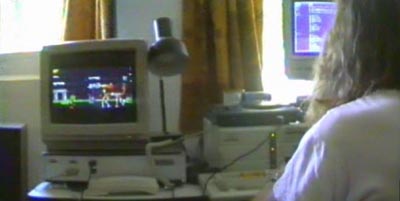
A Multi-system dev-kit (modelled by Jeff Minter)
It is not (currently) known where the complete functioning Prototype Consoles and Chairs ended up. I asked Wyn Holloway directly and you can read his interesting response in the interview. As we've seen and have been able to save, some of the code written for the machine still exists.
I appeal to all of you Developers who were involved with the project to look through your archives of Floppy Disks and see if you can find any Konix code. Maybe then we can finally preserve all your hard work that seemingly went to waste at the time. It would seem to me that a publisher would keep an archive of all the work being produced for their machine (even early builds submitted for approval or vetting) so I'm only speculating, but I'd assume that there was a box of floppies with all the games as they were at that stage out there somewhere.
The Multi-system Slipstream ASIC on the other hand does live on in the form of the AVP chipset used in the Viper / Cobra PCBs which were used in certain BellFruit pub quiz machines. Flare sold their technology to Bellfruit, and interestingly ATD were closely involved in producing code for the system and even went on to develop another system for Bellfruit (which I now believe to be the Bell-Fruit/ATD RasterSpeed which ran the infamous Rise of the Robots game). In terms of preserving the technology, the problem is, that these machines are very old by fruit machine standards, and as such don't become available for purchase very often. It is worth keeping an eye on eBay and the like for these machines turning up as they do occasionally. They are referred to as SWP (skill with prizes) machines (a description stemming from the legal definition pertaining to the classification of gambling machines) rather than the British colloquialism 'fruit machines' or the more generic 'quiz machine'.
Click the arcade machine image to find out more about the Flare / Bellfruit connection.
The Slipstream ASIC also found it's way into an internet Set-Top-Box.
Arguably, the first ever internet Set-Top-Box it was designed and manufactured by MSU, the company Wyn set up after Konix and developed partly by Martin Brennan of Flare, the MSU Slipstream Set-Top-Box very definitely found it's way into production and was pretty successful. This is where they really seemed to start making money.
Maybe one of the readers of this website can help me hunt down a MSU Slipstream Set-Top-Box. It must be said, that although it used a later revision of the ASIC, it definitely wasn't a console. There were no apparent thoughts about making the STB play games.
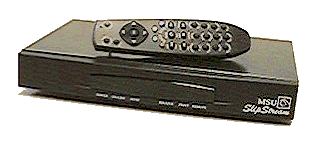
Multi-system in here too!
And most infamously, it's said the Slipstream controller was sold to a Chinese company who called themselves Multi System China (MSC) for 1 Million pounds. This was then turned into an analog joystick with none of the refinements of the original design like judder. Please don't buy one of these controllers thinking you're getting an actual Konix Multi-system (they come up on eBay every now and then) - there are no electronics worth speaking of in the unit, just a PCB for managing the potentiometers, buttons and interface to a PC joystick port. Certainly not even a hint of Konix Multi-system electronics in any way shape or form. However please feel free to buy one as a novelty or a conversation piece.
Although I know for a fact that it was produced using the same mold that was used to produce the Konix Multi-system plastic shell (molds are very expensive to make (we're talking tens of thousands of pounds and possibly more), so it's not surprising an attempt was made to claw back some money from the manufacture of the mold. Where I have my doubts is whether it really was a separate Chinese company or just Konix under a different trading name (this was certainly not unprecedented - I've seen Konix register the name "Betterneat" and patent things under this name).
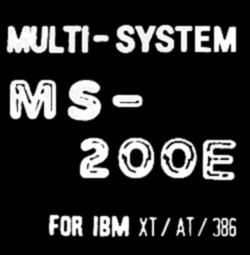
MSC Model description

Totally bizarre MSC Logo
Finally, you can try to argue that the Konix lives on in the Atari Jaguar and therefore just by owning a Jaguar, you can own in essence a Konix Multi-system 2, however my personal take is that the spirit and design methodologies are the only thing in common between the Slipstream and the Jaguar. You won't find the actual Slipstream ASIC, the processors are different, the memory is different; basically, it's like comparing the Michael Caine Italian Job Mini to the Charlieze Theron Italian Job BMW Mini. Same name, VERY different experiences...
Read the Lineage page for further discussion on the evolution of the Konix Multi-system.

